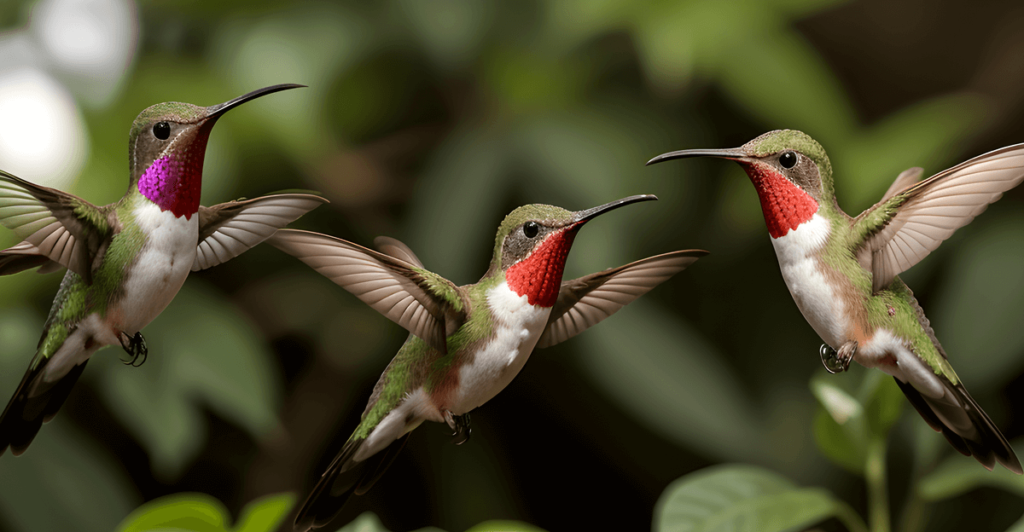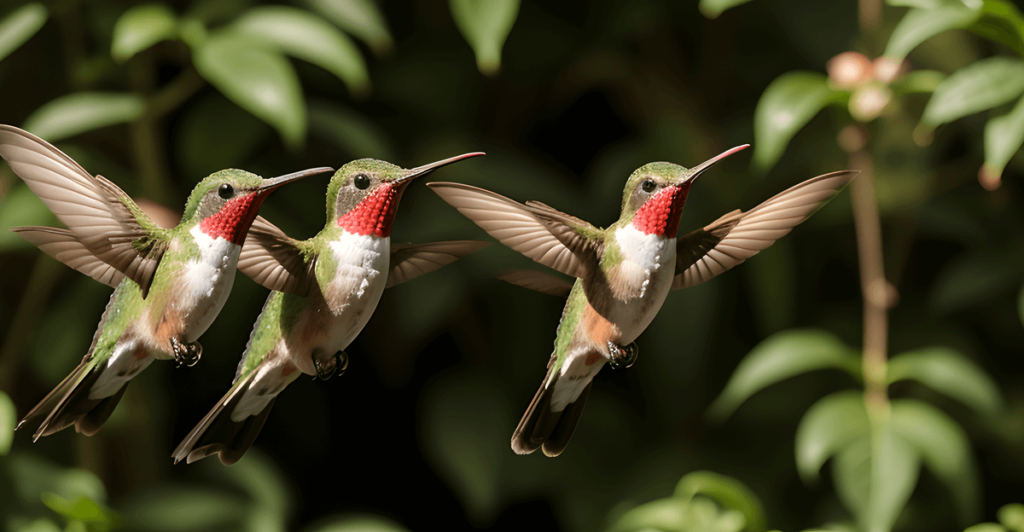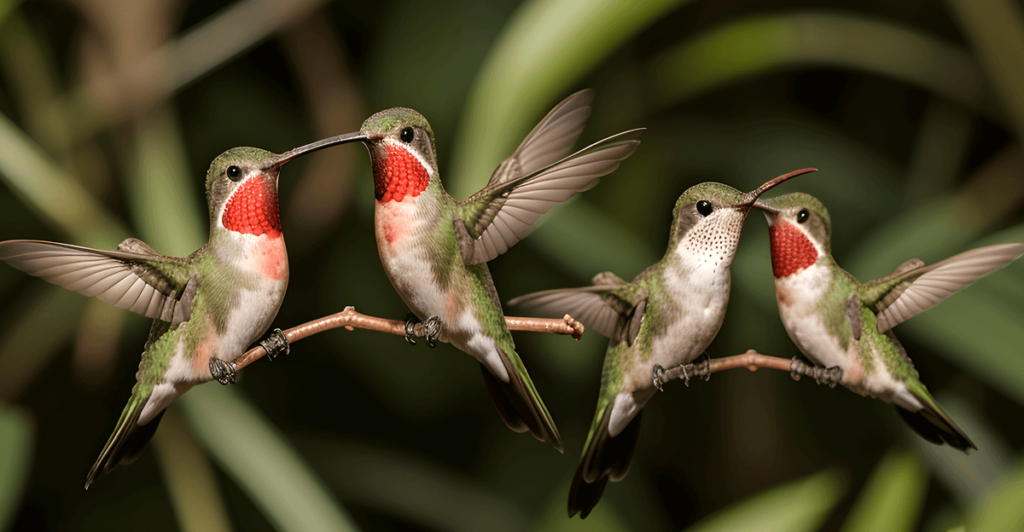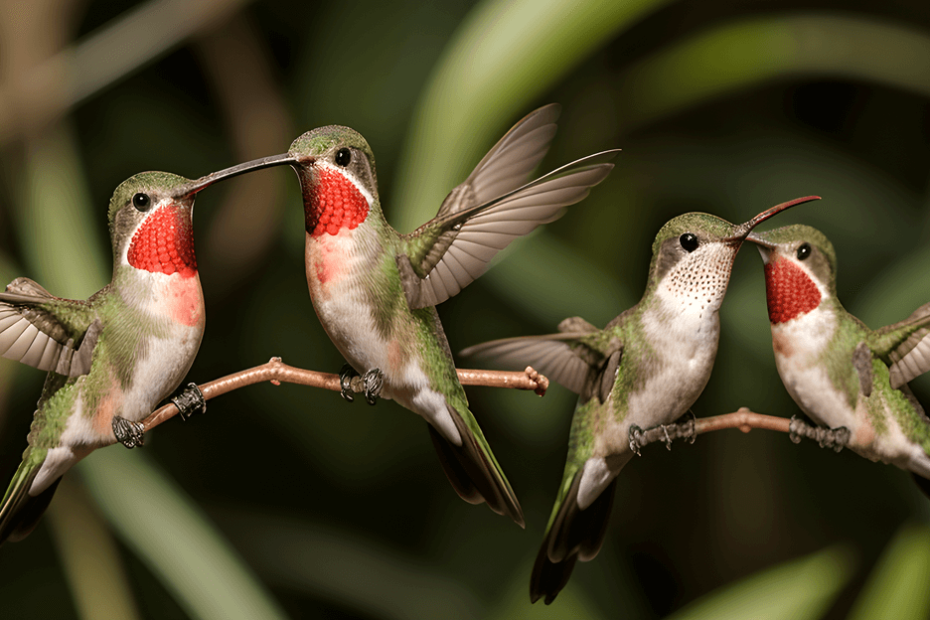Introduction
As an avid birdwatcher and wildlife enthusiast, I’ve spent countless hours observing and studying hummingbirds in their natural habitats. The question “Can hummingbirds be pets?” is one I’ve encountered numerous times throughout my career. In this comprehensive guide, I’ll share my firsthand experiences and expert knowledge to address this intriguing topic.
The Allure of Hummingbirds
The first time I saw a hummingbird up close, I was mesmerized. Its iridescent feathers shimmered in the sunlight as it hovered effortlessly before a flower. The rapid beat of its wings created a soft humming sound that gave these tiny birds their name. It’s no wonder that many people dream of keeping these fascinating creatures as pets.
However, the reality of hummingbird ownership is far more complex than most people realize. In this article, we’ll explore the legal, ethical, and practical aspects of keeping hummingbirds as pets. We’ll also discuss alternatives that allow you to enjoy these remarkable birds without compromising their well-being or breaking the law.

Can Hummingbirds Be Pets? Nature’s Flying Jewels
Before we delve into the question of pet ownership, it’s crucial to understand what makes hummingbirds so unique. During my years of field research, I’ve had the privilege of observing various hummingbird species up close, and their characteristics never cease to amaze me.
Species and Characteristics
There are over 360 known species of hummingbirds, all native to the Americas. Here are some fascinating facts about these tiny marvels:
- Size: Most hummingbirds are 3-5 inches long and weigh 2-20 grams.
- Wing speed: Their wings can beat up to 80 times per second in normal flight, and up to 200 times per second during courtship dives.
- Heart rate: A hummingbird’s heart can beat up to 1,260 times per minute.
- Flight: They are the only birds that can fly backwards and hover in mid-air.
- Metabolism: Hummingbirds have the highest metabolism of any animal, with heart rates that can reach 1,260 beats per minute.
Natural Habitat and Behavior
In my travels across North and South America, I’ve observed hummingbirds in a variety of habitats, from tropical rainforests to arid deserts. These adaptable birds can be found wherever there are flowering plants to provide nectar.
Hummingbirds are solitary creatures, typically coming together only for breeding. They are fiercely territorial, often engaging in aerial battles to defend their feeding areas. I once watched two male Anna’s hummingbirds engage in a spectacular aerial dance, their iridescent gorgets flashing in the sunlight as they vied for dominance.
Can Hummingbirds Be Pets? Diet and Feeding Habits
One of the most fascinating aspects of hummingbird biology is their unique diet. Through my observations, I’ve noted that hummingbirds have some of the most specialized feeding habits in the animal kingdom:
- Nectar: The primary food source, obtained from flowering plants.
- Insects and spiders: Provide essential protein and nutrients.
- Tree sap: Occasionally consumed, especially when nectar is scarce.
- Pollen: Inadvertently consumed while feeding on nectar.
Hummingbirds need to eat every 10-15 minutes and visit between 1,000 to 2,000 flowers per day. Their long, specialized beaks and ability to hover make them perfectly adapted for nectar feeding.
Lifespan: Wild vs. Captivity
In the wild, hummingbirds typically live 3-5 years, although some species can live up to 12 years. However, captive hummingbirds often have shorter lifespans due to the challenges of replicating their natural diet and environment.
| Aspect | Wild Hummingbirds | Captive Hummingbirds |
|---|---|---|
| Average Lifespan | 3-5 years | Often shorter |
| Diet | Natural nectar, insects | Artificial nectar, limited insect variety |
| Exercise | Constant flying, hovering | Limited space for flight |
| Stress Levels | Natural stressors | Additional stress from captivity |
| Social Interaction | Natural mating and territorial behaviors | Limited or no interaction with other hummingbirds |
The Legal Perspective: Can Hummingbirds Be Pets?
As a wildlife conservationist, I’m often asked about the legality of keeping hummingbirds as pets. The answer is clear and unambiguous: it is illegal to keep hummingbirds as pets in the United States and many other countries.
Federal Laws Protecting Hummingbirds
Hummingbirds are protected in the United States by the 1918 Migratory Bird Treaty Act. This federal law makes it illegal to capture, possess, sell, or transport native migratory birds, including hummingbirds, without prior authorization from the U.S. Fish and Wildlife Service.
I once witnessed a well-meaning individual attempt to “rescue” a hummingbird by taking it home. Despite their good intentions, they were unknowingly breaking federal law and potentially harming the bird. It’s crucial to understand that even possessing a feather from a hummingbird can result in fines and legal consequences.
State Regulations on Keeping Wild Birds
In addition to federal laws, many states have their own regulations regarding wildlife. These laws often reinforce federal protections and may impose additional restrictions. For example, in California, where I’ve conducted much of my research, it’s illegal to keep any wild bird as a pet, regardless of how it was acquired.
Consequences of Illegally Keeping Hummingbirds
The penalties for keeping hummingbirds as pets can be severe. When the Migratory Bird Treaty Act is broken, there may be
- Fines up to $15,000
- Up to six months in prison
- Forfeiture of all equipment used to capture or keep the birds
I’ve seen cases where well-intentioned individuals faced legal consequences for keeping injured hummingbirds instead of contacting licensed wildlife rehabilitators. It’s always best to leave wildlife care to trained professionals.
Why These Laws Exist
These laws are in place for good reasons:
- Conservation: Protecting hummingbirds in their natural habitats helps maintain ecosystem balance.
- Animal welfare: Hummingbirds have complex needs that are difficult to meet in captivity.
- Preserving natural behaviors: Captivity can disrupt natural migration patterns and breeding behaviors.
- Preventing wildlife trafficking: Strict laws help prevent the illegal trade of wild birds.

Challenges of Keeping Hummingbirds as Pets
Even if it were legal, keeping hummingbirds as pets would present numerous challenges. Through my work with wildlife rehabilitators, I’ve gained insight into the complex needs of these tiny birds.
Specialized Diet Requirements
Replicating a hummingbird’s natural diet is incredibly challenging. In the wild, they consume:
- Nectar from a variety of flower species
- Small insects and spiders
- Occasional tree sap and pollen
Captive hummingbirds often suffer from malnutrition due to the difficulty of providing this varied diet. I’ve seen the detrimental effects of improper nutrition in rescued hummingbirds, including weakness, feather loss, and stunted growth.
Housing and Space Needs
Hummingbirds require spacious enclosures that allow for flight and hovering. A suitable enclosure would need to be:
- Large enough for sustained flight (at least 8x8x8 feet)
- Equipped with appropriate perches and feeding stations
- Maintained at a constant, warm temperature
- Protected from drafts and sudden temperature changes
Creating such an environment is costly and challenging, even for experienced aviculturists.
Can Hummingbirds Be Pets? Health Concerns and Veterinary Care
Hummingbirds are prone to various health issues in captivity, including:
- Aspergillosis (fungal infection)
- Bacterial infections
- Stress-related illnesses
- Injuries from collisions with enclosure walls
Finding veterinarians with expertise in hummingbird care is extremely difficult. During my time working with wildlife rescues, I’ve seen how even minor health issues can quickly become life-threatening for these delicate birds.
Stress and Impact on Hummingbird Well-being
Captivity is inherently stressful for wild animals, especially those as active and high-energy as hummingbirds. Signs of stress in captive hummingbirds include:
- Reduced feeding
- Excessive vocalization
- Feather plucking
- Lethargy or hyperactivity
I once observed a rescued hummingbird at a wildlife center that displayed clear signs of stress, despite the best efforts of the care team. It was a stark reminder of how ill-suited these birds are to captive environments.
Alternatives to Keeping Hummingbirds as Pets
While we can’t keep hummingbirds as pets, there are many rewarding ways to enjoy and support these remarkable birds. Through my years of birdwatching and conservation work, I’ve discovered several fulfilling alternatives.
Creating a Hummingbird-Friendly Garden
One of the most rewarding experiences I’ve had is transforming my backyard into a hummingbird haven. Here are some tips based on my personal success:
- Plant native flowers: Choose nectar-rich plants that bloom at different times of the year.
- Avoid pesticides: These can harm hummingbirds and reduce insect populations they rely on.
- Provide water: A shallow, moving water source like a fountain can attract hummingbirds.
- Create perches: Thin, bare branches give hummingbirds a place to rest and survey their territory.
My Garden Success Story: After implementing these changes, I saw a dramatic increase in hummingbird activity. Within a year, I had regular visits from three different species, including a nesting pair of Ruby-throated Hummingbirds!
Setting Up and Maintaining Hummingbird Feeders
Properly maintained feeders can supplement natural nectar sources and provide excellent viewing opportunities. Here’s what I’ve learned about effective feeder management:
- Use the right nectar: Mix 1 part white sugar with 4 parts water. Avoid honey, artificial sweeteners, or red dye.
- Clean feeders regularly: At least twice a week, more often in hot weather.
- Place feeders strategically: Near flowers, in partial shade, and away from windows.
- Provide multiple feeders: This reduces competition and territorial behavior.
Feeder Maintenance Tips: I change my feeders every other day in summer to prevent fermentation and mold growth. It’s extra work, but the increased hummingbird activity is well worth it!
Participating in Hummingbird Conservation Efforts
Getting involved in conservation is a fantastic way to support hummingbirds. Some ways I’ve contributed include:
- Citizen science: Participating in programs like eBird or the Hummingbird Monitoring Network.
- Habitat restoration: Volunteering for local projects that restore native plant communities.
- Education: Sharing knowledge about hummingbirds with friends, family, and community groups.
Personal Experience: I’ve been involved with a local habitat restoration project for the past three years. Seeing the gradual increase in hummingbird populations as we’ve reintroduced native plants has been incredibly rewarding.
Observing and Photographing Wild Hummingbirds
Watching and photographing hummingbirds in their natural habitat can be just as exciting as having them as pets. Here are some tips I’ve picked up:
- Use a long lens: A telephoto lens (300mm or longer) allows you to capture detail without disturbing the birds.
- Be patient: Spend time observing to learn feeding patterns and favorite perches.
- Use a fast shutter speed: At least 1/1000th of a second to freeze wing motion.
- Consider using a blind: This allows you to get closer without frightening the birds.
Photography Success: After months of practice, I finally captured a stunning image of a male Anna’s Hummingbird with its gorget fully illuminated. The photo now hangs in my living room, a constant reminder of the beauty of these birds in their natural state.

Ethical Considerations: Should Hummingbirds Be Pets?
As a wildlife ethicist, I often contemplate the moral implications of our interactions with animals. The question of whether hummingbirds should be pets goes beyond legal considerations and touches on deeper ethical issues.
Impact on Wild Populations
Removing hummingbirds from the wild, even in small numbers, can have significant ecological impacts:
- Disruption of pollination services
- Alteration of local ecosystem balance
- Potential genetic consequences for small populations
I’ve witnessed firsthand how the loss of even a few individuals can affect a local hummingbird population. In one study area, the removal of three breeding pairs led to a noticeable decrease in pollination rates of certain plant species.
Animal Welfare Concerns
Keeping hummingbirds in captivity raises serious welfare concerns:
- Stress: The constant activity of hummingbirds is difficult to accommodate in captivity.
- Nutritional deficiencies: Replicating their complex diet is challenging.
- Lack of natural behaviors: Captivity prevents migration, natural foraging, and mating.
- Shortened lifespan: Captive hummingbirds often don’t live as long as their wild counterparts.
During my work with wildlife rehabilitators, I’ve seen the negative effects of even short-term captivity on hummingbirds. The stress of confinement can lead to rapid health deterioration.
Conservation Efforts and Importance of Wild Hummingbirds
Hummingbirds play crucial roles in their ecosystems:
- Pollination: They pollinate a wide variety of plants, including some that rely exclusively on hummingbirds.
- Insect control: Their insectivorous diet helps control pest populations.
- Biodiversity indicators: Hummingbird presence often indicates a healthy, diverse ecosystem.
Case Study: In a reforestation project I was involved with, the return of hummingbirds to the area was one of our key indicators of success. Their presence signaled that we had restored not just the plants, but the entire ecological network.
Balancing Human Desire with Animal Needs
While the desire to keep hummingbirds as pets is understandable, it’s important to prioritize the birds’ needs and well-being. In my experience, the joy of observing hummingbirds in their natural habitat far outweighs any benefits of keeping them in captivity.
“The details in the natural world are what give it its beauty.” – Natalie Angier
This quote resonates deeply with my experiences observing hummingbirds. The intricate details of their behavior and ecology are best appreciated in their natural setting.
Frequently Asked Questions About Hummingbirds as Pets
Throughout my career, I’ve encountered many questions about hummingbirds. Here are some of the most common, along with answers based on my experience and expertise:
Can I rescue and keep an injured hummingbird?
No, you should not keep an injured hummingbird. If you find an injured hummingbird, the best course of action is to contact a licensed wildlife rehabilitator immediately. These professionals have the expertise and legal authority to care for injured wildlife.
Personal Experience: I once found an injured Anna’s Hummingbird in my garden. Instead of trying to care for it myself, I contacted a local wildlife rescue. They were able to treat the bird’s injured wing and release it back into the wild within a week.
Are there any exceptions to keeping hummingbirds legally?
The only legal way to keep hummingbirds in captivity is with proper permits for scientific research, education, or rehabilitation purposes. These permits are typically issued to institutions or licensed individuals, not to private individuals.
Expert Insight: In my work with ornithological research teams, I’ve seen the stringent requirements for obtaining and maintaining these permits. They require extensive training, proper facilities, and ongoing reporting to wildlife authorities.
How do I help a hummingbird in distress?
If you encounter a hummingbird in distress, follow these steps:
- Observe from a distance to confirm the bird is genuinely in need of help.
- If the bird is in immediate danger, gently place it in a small, ventilated box lined with a soft cloth.
- Keep the bird in a quiet, warm area.
- Do not attempt to feed the bird.
- Contact a licensed wildlife rehabilitator or your local wildlife authority immediately.
Real-life Example: During a heatwave, I found a dehydrated hummingbird on my patio. I carefully placed it in a shoebox with air holes and a soft towel, kept it in a cool, quiet spot, and called our local wildlife rescue. They arrived within an hour and were able to rehydrate and release the bird the same day.
